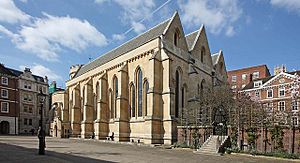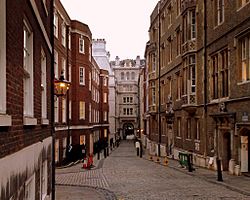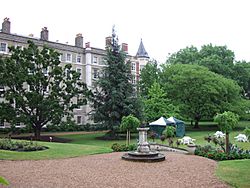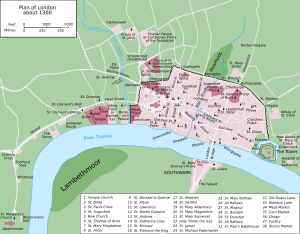Temple, London facts for kids
Quick facts for kids Temple |
|
|---|---|
 Temple Church |
|
| Sui generis | |
| Administrative area | Greater London |
| Region | |
| Country | England |
| Sovereign state | United Kingdom |
| Post town | LONDON |
| Postcode district | EC4 |
| Postcode district | WC2 |
| Dialling code | 020 |
| Police | City of London |
| Fire | London |
| Ambulance | London |
| EU Parliament | London |
| UK Parliament |
|
| London Assembly | |
The Temple is a special area in the City of London. It surrounds the historic Temple Church. This area has been a major center for English law for hundreds of years. It includes two important legal groups called the Inner Temple and the Middle Temple. These groups are two of the four Inns of Court. They act like local governments for most things in the area.
Before these legal groups, the Temple area belonged to the Knights Templar. They were a famous group of knights who built the church. They were stopped in 1312, but the area kept their name. Soon after, it became a key place for lawyers.
The Royal Courts of Justice are just north of the Temple. Temple tube station is to the southwest. The Temple area is bordered by the River Thames to the south. It also touches Surrey Street, the Strand, Fleet Street, Carmelite Street, and Whitefriars Street.
Contents
What is the Temple Area Like?
The Temple area has many offices for lawyers called barristers' chambers. It also has offices for solicitors. These are important legal buildings.
Some other buildings are near Temple tube station. These are outside the main Temple area. One is Arundel House, which holds the International Institute for Strategic Studies.
Where Did the Name "Temple" Come From?
The name "Temple" was first used in the 1100s. It was called Novum Templum, meaning 'New Temple'. This name came from the 'new' church (Temple Church) and the land around it. This land belonged to the Knights Templar. Their 'Old Temple' was in a different part of London.
Today, "Temple" is part of many names in the area. These include Inner Temple, Middle Temple, Temple Bar, and Temple tube station. After the Knights Templar were stopped in 1312, their land was split. It became the Inner Temple and the Outer Temple. Inner Temple was later split into Inner and Middle. The name Outer Temple is not used much anymore.
A Quick Look at Temple's History
The Temple area was first owned by the Knights Templar. They built the Temple Church to honor Solomon's Temple in Jerusalem. The Knights had two large halls. Today, these are the Middle Temple Hall and the Inner Temple Hall. The Inner Temple Hall still has parts of the old medieval hall.
In 1312, the Knights Templar group was ended. Their land was given to another group, the Knights Hospitaller. But King Edward II (who ruled from 1307 to 1327) did not agree. He split the Temple into Inner Temple and Outer Temple. Inner Temple was inside the City of London. Outer Temple was outside.
It took until 1324 for the Knights Hospitaller to officially get the Inner Temple. Even then, King Edward II gave it to his friend, Hugh Despenser the Younger. After Hugh died in 1326, the Inner Temple went to the mayor of London. Then, in 1333, it was leased to a King's clerk for ten years.
In 1337, the Knights asked Edward III to fix the land grant. As a result, Inner Temple was split again. The eastern part stayed Inner Temple. The western part became known as Middle Temple.
By 1346, the Knights Hospitaller leased both Middle and Inner Temples to lawyers. However, lawyers had been using the Temple since 1320.
Later, Henry VIII ended the Knights Hospitaller in England. The lawyers stayed as tenants of the King. They paid a yearly rent for each group (Inner and Middle Temple). In 1608, King James I gave them a special charter. This gave the lawyers full ownership of the land.
The Outer Temple area was given to the Bishop of Exeter. It was later bought by the Earl of Essex, Robert Devereux. Streets like Essex Street and Devereux Court are named after him.
The Temple area grew when the River Thames was changed. The Victoria Embankment was built from 1865 to 1870. This created new land to the south. You can still see where the old river bank was.
The area was badly damaged during World War II air raids. Many buildings, including Temple Church, had to be rebuilt. Even so, the Temple has many beautiful historic buildings.
Inner Temple and Middle Temple


The main part of the Temple is in the City of London. It has two Inns of Court: Inner Temple (on the east) and Middle Temple (on the west). The Temple Church is between them. Both Inns manage the church together.
Each Inn has its own gardens, dining halls, and libraries. They also have offices. Most of the land is used for buildings where barristers work. These are called chambers.
For a long time, the two Inns argued about which one was older. In 1620, four judges decided that all four Inns of Court should be equal. No one was more important than the other.
Until the 1900s, many chambers in the Temple were also homes for barristers. But as more space was needed for work, fewer people lived there. Now, only the top floors are used as homes. Senior barristers and judges often use them as a second home. This means the Temple is much quieter after work hours.
Today, about a quarter of the buildings in Inner and Middle Temple have homes. The plan is to keep these homes. This helps keep the special "college-like" feel of the Temple Inns of Court.
There is also a building called "The Outer Temple" from the 1800s. It is outside the Middle Temple area. It is not part of the modern Inns of Court.
An area called Serjeant's Inn was once outside the Temple. It was also used by lawyers. In 2001, the Inner Temple bought it. They planned to make it into lawyers' offices. But it became a hotel instead.
Special Status of the Liberties
Inner Temple and Middle Temple are special areas called liberties. This is an old name for a local administrative division. They are independent areas. Historically, they were not ruled by the City of London Corporation. They were also outside the church's control.
Today, they act like local authorities for most things. They can ask the City of London to help with some tasks. They are located within the City of London. But they are like independent enclaves. They are both part of the City ward of Farringdon Without. In 1832, the Temple was included in the City of London's voting area.
The southern border of the Temple liberties was the River Thames. This changed when the Victoria Embankment was built (1865–1870). The Embankment is a major road with an Underground line. It is not part of the Temple. The Temple's border is where the gardens meet the road.
Temple Church
The Temple Church is a very old church. It was built by the Knights Templar. It was officially opened in 1185. Both the Middle Temple and Inner Temple Inns own it together.
Temple Tube Station and Pier
The Temple area gives its name to Temple tube station. You can catch the District (green) and Circle (yellow) trains there. The station is just southwest of the Temple.
There is also a Temple Pier on the Victoria Embankment. It is near the Tube station. The ship HQS Wellington is always docked there.
Images for kids
See also
 In Spanish: Temple (Londres) para niños
In Spanish: Temple (Londres) para niños









